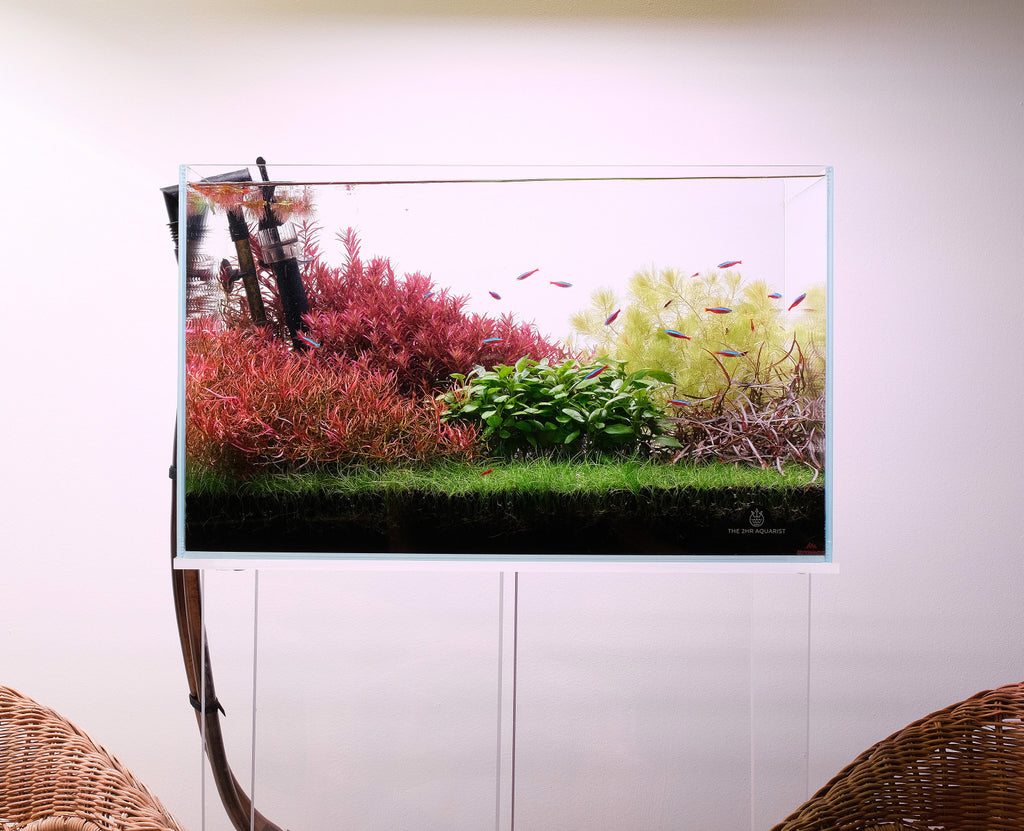Your Cart is Empty
Shop
We are a brand born of an obsession with performance, a belief in good science, and a knack for invention.
Read our story.
We are a brand born of an obsession with performance, a belief in good science, and a knack for invention.
Read our story.

Good Science
We define it as a combination of discerning research and real world results.
We define it as a combination of discerning research and real world results.

The best LED units for planted tanks in 2024
March 05, 2024 4 min read

Tank above lit by Week Aqua p900 and Chihiros Vivid2 LEDs.
What differentiates cheaper vs higher end LED lights?
 The above pictures are taken on the same day using similar settings on the camera - the color differences are even more significant in real life compared to the pictures above. While generic LED floodlights or even desk lamps can grow plants well, the visual color rendition of such units is not great.
The above pictures are taken on the same day using similar settings on the camera - the color differences are even more significant in real life compared to the pictures above. While generic LED floodlights or even desk lamps can grow plants well, the visual color rendition of such units is not great.
LEDs are now very commonly used in aquariums. They are more energy efficient compared to older fluorescent lighting and many come with customization spectrum and programming as well. However, not all LED sets produce the same quality of light - there is a huge difference in both output and color rendering depending on the type of LEDs used and the diode arrangement.
Budget LEDs tend to produce washed out colors. This is not a universal rule, but a generalization true for many cheaper lights as shown above. This means that visual color saturation is less much appealing - red and greens are less vibrant. Such lighting can still grow plants well, it is just that the visual presentation of the colors is less ideal.
This is largely due to the usage of cheaper white LED diodes, which generally lack red spectrum. Most white LEDs have a fair amount of blue, and significant amounts of green/yellow, but lack red. A sample 6500k LED's spectrum curve is shown below - it has a large peak in blue and a lot of green and yellow in the spectrum but not much red.
To improve the situation, many LEDs that claims to be full spectrum or "RGB" uses a mix of white and red/blue LED in addition to white LEDs. Even though this adds additional red spectrum to the light, much of the spectrum is still dedicated to large amounts of green/orange. This type of LED has a better spectrum than the one above. However, it is still not ideal. Having a broad spectrum dilutes the visual saturation of plant colors overall, even though it looks like the light has good coverage across the whole usable light spectrum. Once again, such a spectrum grows plants perfectly well, but does not give the best color rendering/saturation. Common brands that use such a diode arrangement include Hygger and Ai prime.

A more ideal LED arrangement?
In recent years some LED makers made use of Red Green Blue diodes to replace most or all of the white diodes. Using only Red, Green and Blue diodes to produce white light gives a spectrum curve more like the one below. We see a high saturation in the 3 peaks; Red, Blue and Green with big gaps in between. This narrow spectrum approach seems counter-intuitive for folks that think that we need to replicate the broad spectrum of sunlight to grow plants well, however, not only do the LEDs that use such spectrum grow plants very well, they also give much higher visual color contrast to broader spectrum LED models, and render richer looking color tones for Green, Yellow etc as well.
This color saturation is much more apparent in real life than in pictures. For the best experience, one should visit an aquarium shop to see the color rendering differences of different fixtures in real life.

Such a LED diode arrangement gives high color saturation, enhancing red and green tones but still maintaining a neutral white background color tone. As shown below:


Good saturation of colors without an overly purplish back cast - Week Aqua a430 above, and Chihiros vivid below.
The LEDs that make use of the narrow spectrum bandwidth approach include:
These are the fixtures we recommend for folks looking for LEDs with diode arrangements that give higher color saturation and contrast.
Some more examples:
 This tank above is lit by an LEDstar unit.
This tank above is lit by an LEDstar unit.
 Photo from Viktor Lantos, Green aqua showing ADA solar RGB.
Photo from Viktor Lantos, Green aqua showing ADA solar RGB.
Comparison of ADA solar RGB and some other fixtures:
Comparison of Chihiros Vivid and other Chihiros fixtures (the WRGB 2 has same spectrum as the Vivid):
Differences between the different brands
The Chihiros vivid is programmable with custom spectrum tuning and timing and the app has improved since the earlier versions. The ADA solar RGB is a no frills unit (no custom spectrum, no timer function) but carries the ADA brand name. Due to exact diodes chosen for their RGB profile; there is also slight differences in visual coloration - the ADA solar RGB has a slightly deeper green tone compared to the Maxlite and Chihiros vivid. ONF Flat one and Twinstar S have more rounded spectrums with less contrast compared to the rest; it may look more 'natural' but less saturated. Week Aqua has recently entered the market and their lights have good spectrum selection with the addition of UV diodes that other LEDs lack and are programmable (both spectrum and timer).
unlock your true potential
Grow anything, defeat algae, create amazing aquascapes
























